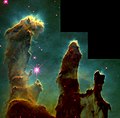



The Space Telescope Imaging Spectrograph (STIS) is a spectrograph, also with a camera mode, installed on the Hubble Space Telescope. Aerospace engineer Bruce Woodgate of the Goddard Space Flight Center was the principal investigator and creator of the STIS. [1] [2] It operated continuously from 1997 until a power supply failure in August 2004. [3] After repairs, it began operating again in 2009. The spectrograph has made many important observations, including the first spectrum of the atmosphere of an extrasolar planet, HD 209458b.
Contents
The STIS was installed on Hubble in 1997 during its second servicing mission (STS-82) by Mark Lee and Steven Smith, replacing the High Resolution Spectrograph and the Faint Object Spectrograph. It was designed to operate for five years. On August 3, 2004, an electronic failure rendered STIS inoperable, ending its use 2 years beyond its predicted lifespan. In order to bring it back to operational status, the instrument was repaired by space shuttle astronauts during STS-125, Servicing Mission 4, launched on May 11, 2009. [4] The crew did a long (many hour) EVA to repair the instrument. [5]
Congratulations, you brought STIS back to life.
— Astronaut J. Grunsfield, 2009 [5]


